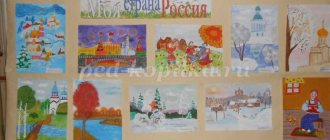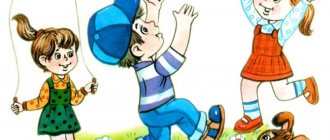Notes “Introduction to the chessboard” lesson plan (senior group) on the topic
Topic: “Introduction to the chessboard.”
Goal: to consolidate children’s ideas about the chessboard and its features; develop plane orientation, memory, cultivate independence, attentiveness, and patience.
Tasks:
1. Introduce children to the features of the chessboard, some terms used in chess: horizontal, vertical.
2. Teach children to correctly alternate colors when making a chessboard layout.
3. Cultivate interest in playing chess.
Methods: visual, heuristic, verbal.
Equipment: chess demonstration board with a set of pieces, computer with speakers, screen with projector, wonderful bag, chess boards for each pair of students, presentation by I.G. Sukhin “Lena, Olya, Baba Yaga and chess” (part 1), lined paper “chess” boards (on large-checked notebook sheets), black or simple pencils for coloring, chips or circles in green and yellow colors.
Move
1. Introductory part.
Educator: Good afternoon!
— You and I will go to the Black and White Kingdom.
2. Main part.
Educator: What is this? (Takes out a chessboard from a wonderful bag).
Children: This is a chessboard.
Educator: That's right, this is a chessboard that keeps many secrets, which you and I will soon learn about. And who knows why the Kingdom is called Black and White?
Children: Because the board has black and white cells.
Educator: What are these cells called?
Children: These squares in chess are called fields; there are black squares and white squares on the board.
Educator: Who can tell me how the fields are located on the chessboard?
Children: In order, alternately, white and black alternate.
Educator: How many of you remember how many white spaces are on the board?
Children: 32.
Educator: And blacks?
Children: Also 32.
Educator: Which fields are more black or white?
Children: The same, their equal number, equally, there are as many white fields as black ones.
Educator: Correct. There are 32 whites and 32 blacks, for a total of 64 squares.
Educator: The board has one secret. Who knows how to set up a chessboard correctly?
Educator: The board should lie so that the lower right field is white. And also make sure that there is a number 1 next to this field.
Educator: Guys, you know, there are streets in the Chess Kingdom. Those streets that go from left to right are called Horizontals, and those streets that are located from top to bottom are called Verticals. Count how many vertical streets there are?
Children: 8.
Educator: How many horizontal ones?
Children: 8.
Educator: Who can show 1 vertical? What about 3? What about 6? Etc.
Children practice showing verticals first, then horizontals.
Physical exercise.
Educator: And now everyone has stood up. Show the horizontal with your hands, who guessed how this can be done? (Hands to the side). They gave up. Show the horizontal line again. Well done.
How can you show the vertical? (One hand is below, the other is above).
Educator: Take your seats.
Let's play the game "The Most Attentive". You need to use circles to lay out verticals and diagonals.
D/i "Horizontals and verticals". Two players take turns laying out the horizontal and vertical lines of the chessboard (with chips or circles of different colors: for example, vertical - lay out green circles, horizontal - yellow).
Educator: Now let's watch the fairy tale "Lena, Olya, Baba Yaga and Chess."
View presentation by I.G. Sukhin “Lena, Olya, Baba Yaga and chess” (part 1) - about horizontals, verticals.
Educator: And someone is knocking on our door. (The postman brought an envelope with the task).
Educator: Guys, this is a letter from the inhabitants of the Chess Kingdom. They left small chess boards for us, only they are somehow strange, all white. (Shows pre-prepared lined paper boards). Probably, the inhabitants of the Black and White Kingdom want us to color the boards, correctly alternating black and white fields. Can you handle it?
Children: Yes!
Children color their little chess boards.
3. Bottom line.
Educator: Great, everyone completed the task, but we will only find out who lives in the Black and White Kingdom in the next lesson.
Goodbye.
Literature
1. Sukhin I.G. Chess, first year, or Studying and teaching: A manual for teachers - Obninsk: Spiritual Revival, 2011.
2. Sukhin I.G. Chess, first year, or There the black and white squares are full of wonders and secrets: a textbook for elementary school, first year of study. In 2 parts. Part 1.- 4th ed. – Obninsk: Spiritual Revival, 2012. – 80 p., ill.





